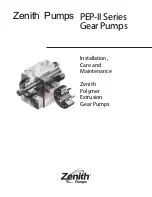
5
WARNING!
As soon as the RIP enclosure is open all solid state relays become open.
To mute the RIP buzzer, open the RIP cover and operate the tamper switch three times
for a short time each and then for a long time once.
‘Long time’ here means keeping the tamper switch pressed within a time between 1.5 s
and 3 s. ‘Short time’ means keeping the tamper switch pressed within 0.1 to 0.5 s. Pauses
between presses should be at least 0.1 s not exceeding 1 s.
2.3
Turning the RIP On
2.3.1
Make sure that the mounting is performed correctly and as shown in the RIP-12
mod.14 (RIP-12-2/7P2-R) (see Figure 3).
2.3.2
Connect the battery to the relevant terminals observing polarity (the red wire is to
be connected to the positive lead of the battery).
2.3.3
Insert the fuse F1.
2.3.4
Switch mains power 220 V, 50 Hz on.
2.4
Operation of the RIP
2.4.1
After being powered on, the RIP microcontroller checks the presence of a battery.
If the battery is available, the BAT indicator shows solid light. If the battery is not charged,
the RIP will charge it until its voltage reaches the required value, the BAT indicator
switching off for a short time once every 3 s. If no battery is connected (or its output voltage
is less than 7 V) then the BAT indicator is off.
2.4.2
While operating, the RIP periodically inspects:
–
Availability of a battery (at least once per minute);
–
Battery conditions (at least once per 15 minutes);
–
Operability of the battery charger (at least once per 15 minutes);
–
Presence of mains voltage;
–
No overload and no short circuit conditions at the output.
2.4.3
If no mains power is applied then the load starts to be powered by the battery, the
buzzer periodically emitting low battery warning beeps, the POWER LED being off, and the
BAT LED and 12 V LED illuminating.
2.4.4
If the battery voltage has dropped down to 11 V, the RIP starts playing interrupted
beeps 10 to 15 times more frequently. Immediately actions must be taken to repair mains
power voltage.
2.4.5
If the battery voltage has dropped down to 10 V, the RIP disconnects the battery
from the load to avoid deep discharge. In this case the 12 V indicator switches off while the
buzzer sounds continuously within two first hours. Upon expiration of two hours the buzzer
issues a quick sound every 10 s.
The buzzer can be disabled by pressing on the tamper switch (see Section 2.2.7). Turning
the buzzer on is performed by repeating the same combination of presses on the tamper
switch.
ATTENTION!
In case of opening the RIP housing all the solid state relays enter the open state.
2.4.6
If mains power 220 V is expected to be off for a time longer than 7 days, then to
avoid deep discharge disconnect the battery from the RIP PCB.
2.4.7
For remote indication of availability of mains power voltage, output voltage, and
battery voltage connect the outputs of the solid state relays
К
1,
К
2, and
К
3 to the alarm
detection circuits of control equipment as shown in Figure 3. Conditions of the solid state
circuits can be found in Table 1.


























